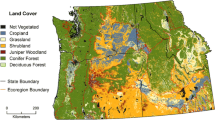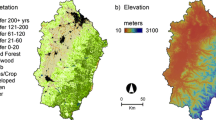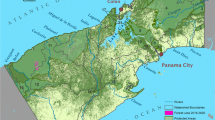Abstract
Forest regrowth after cropland abandonment and urban sprawl are two counteracting processes that have influenced carbon (C) sequestration in the southeastern United States in recent decades. In this study, we examined patterns of land-use/land-cover change and their effect on ecosystem C storage in three west Georgia counties (Muscogee, Harris, and Meriwether) that form a rural–urban gradient. Using time series Landsat imagery data including MSS for 1974, TM for 1983 and 1991, and ETM for 2002, we estimate that from 1974 to 2002, urban land use in the area has increased more than 380% (that is, 184 km2). Most newly urbanized land (63%) has been converted from forestland. Conversely, cropland and pasture area has decreased by over 59% (that is, 380 km2). Most of the cropland area was converted to forest. As a result, the net change in forest area was small over the past 29 years. Based on Landsat imagery and agricultural census records, we reconstructed an annual gridded data set of land-cover change for the three counties for the period 1850 to 2002. These data sets were then used as input to the Terrestrial Ecosystem Model (TEM) to simulate land-use effects on C fluxes and storage for the study area. Simulated results suggest that C uptake by forest regrowth (approximately 23.0 g C m−2 y−1) was slightly greater than the amount of C released due to deforestation (approximately 18.4 g C m−2 y−1), thus making the three counties a weak C sink. However, the relative importance of different deforestation processes in this area changed significantly through time. Although agricultural deforestation was generally the most important C-release process, the amount of C release attributable to urbanization has increased over time. Since 1990, urbanization has accounted for 29% of total C loss from the study area. We conclude that balancing urban development and forest protection is critically important for C management and policy making in the southeastern United States.





Similar content being viewed by others
References
Arnold CL, Gibbons CJ. 1996. Impervious surface coverage: the emergence of a key environmental indication. J Am Plan Assoc 62:243–58
Birdsey RA, Lewis BM. 2002. Carbon in U.S. Forests and Wood Products, 1987–1997: state-by-state estimates. General Technical Report NE-310. Washington (DC): US Department of Agriculture Forest Service. 47 p
Bousquet P, Peylin P, Ciais P, Le Quere C, Friedlingstein P, Tans PP. 2000. Regional changes in carbon dioxide fluxes of land and oceans since 1980. Science 290:1342–6
Brown SL, Schroeder PE. 1999. Spatial patterns of aboveground production and mortality of woody biomass for eastern US forests. Ecol Appl 9:968–80
Brown SL, Schroeder PE, Kern JS. 1999. Spatial distribution of biomass in forests of the eastern USA. For Ecol Manage 123:81–90
Fan S, Gloor M, Mahlman J, Pacala S, Sarmiento J, Takahashi T, Tans P. 1998. A large terrestrial carbon sink in North America implied by atmospheric and oceanic carbon dioxide data and models. Science 282:442–6
Felzer B, Kicklighter DW, Melillo JM, Wang C, Zhuang Q, Prinn R. 2004. Effects of ozone on net primary production and carbon sequestration in the conterminous United States using a biogeochemistry model. Tellus 56B:230–48
Goodale CL, Apps MJ, Birdsey RA, Field CB, Heath LS, Houghton RA, Jenkins JC, et al. 2002. Forests carbon sinks in the Northern Hemisphere. Ecol Appl 12:891–9
Guo LB, Gifford RM. 2002. Soil carbon stocks and land use change: a meta analysis. Global Change Biol 8:345–60
Hart JF. 1980. Land use change in a piedmont county. Ann Assoc Am Geogr 70:492–525
Houghton RA. 1999. The annual net flux of carbon to the atmosphere from changes in land use 1850–1990. Tellus 51B:298–313
Houghton RA, Hackler JL, Lawrence KT. 1999. The US carbon budget: contributions from land-use change. Science 285:574–8
Imhoff ML, Tucker CJ, Lawrence WT, Stutzer DC. 2000. The use of multisource satellite and geospatial data to study the effect of urbanization on primary productivity in the United States. IEEE Trans Geosci Remote Sens 38:2549–56
Jensen JR, Ed. 1996. Introductory digital image processing. 2nd ed. Prentice-Hall Upper saddle River, New Jersey
Lockahy BG, Zhang D, McDaniel J, Tian H, Pan S. 2005. Interdsciplinary research at the urban–rural interface: the Westga Project. Urban Ecosyst 8:7–21
McGuire AD, Sitch S, Clein JS, Dargaville R, Esser G, Foley J, Heimann M, et al. 2001. Carbon balance of the terrestrial biosphere in the twentieth century: analyses of CO2, climate and land use effects with four process-based ecosystem models. Global Biogeochem Cycles 15:183–206
McNulty SG, Vose JM, Swank WT, Aber JD, Federer CA. 1994. Regional-scale forest ecosystem modeling: database development, model predictions and validation using a Geographic Information System. Clim Res 4:223–31
Milesi C, Elvidge CD, Nemani RR, Ruuning SW. 2002. Assessing the impact of urban land development on net primary productivity in the southeastern United States. Remote Sens Environ 86:401–10.
Miller DA, White RA. 1998. A conterminous United States multi-layer soil characteristics data set for regional climate and hydrology modeling. Earth interactions 2: Available Online at: http://www.EarthInteractions.org
Mitchell TD, Jones PD (2005) An improved method of constructing a database of monthly climate observations and associated high-resolution grids. Int J Climatol 25: 693–712
Nadelhoffer K, Aber JD, Melillo JM. 1985. Fine roots, net primary production, and soil nitrogen availability: a new hypothesis. Ecology 66:1377–90
Pacala SW, Hurtt GC, Baker D, Peylin P, Houghton RA, Birdsey RA, Heath L, et al. 2001. Consistent land- and atmosphere-based U.S. carbon sink estimates. Science 292:2316–1320
Schimel D, Melillo JM, Tian H, McGuire AD, Kicklighter DW, Kittel T, Rosenbloom N, et al. 2000. Contribution of increasing CO2 and climate to carbon storage by ecosystems in the United States. Science 287:2004–6
Song C, Woodcock CE. 2003. A regional forest ecosystem carbon budget model: impacts of forest age structure and land-use history. Ecol Model 164:33–47
Teskey RO, Bongarten BC, Cregg BM, Dougherty PM, Hennessey TC. 1987. Physiology and genetics of tree growth response to moisture and temperature stress: an examination of the characteristics of loblolly pine (Pinus taeda L.). Tree Physiol 3:41–61
Thompson MT, Thompson LW. 2002. Georgia’s forests, 1997. Resource Bulletin SRS-72. Southern Research Station, US Department of Agriculture, Forest Service. Available online at: http://www.treesearch.fs.fed.us/pubs/srs/
Tian H, Melillo JM, Kicklighter DW, McGuire AD, Helfrich JVK III, Moore B III, Vörösmarty CJ. 1998. Effect of interannual climate variability on carbon storage in Amazonian ecosystems. Nature 396:664–7
Tian H, Melillo JM, Kicklighter DW, McGuire AD, Helfrich J. 1999. The sensitivity of terrestrial carbon storage to historical atmospheric CO2 and climate variability in the United States. Tellus 51B:414–52
Tian H, Melillo JM, Kicklighter DW, Pan S, Liu J, McGuire AD, Moore B III. (2003). Regional carbon dynamics in monsoon Asia and its implications for the global carbon cycle. Global Planet Change 37:201–17
Turner DP, Koerper GJ, Harmon ME, Lee JJ. 1995. A carbon budget for forests of the conterminous United States. Ecol Appl 5:421–36
USDA Forest Service. 2005. Forest inventory and analysis national core field guide: ver 3: Vol I. Available online at: http://www.fia.fs.fed.us/library/field-guides-methods-proc/
Waisanen PJ, Bliss N 2002. Changes in population and agricultural land in conterminous United States counties, 1790 to 1997. Global Biogeochem Cycles 16:1137–1156
Wear DN. 2002. Land use. In: Wear DN, Greis JG, Eds. Southern forest resource assessment final report. Available online at: http://www.srs.fs.usda.gov/sustain/report/
Wofsy SC, Harriss RC. 2002. The North American Carbon Program (NACP). Report of the NACP Committee of the US Interagency Carbon Cycle Science Program. Washington (DC): US Global Change Research Program.
Acknowledgment
This study was supported by the Auburn University Peak of Excellence Program, the EPA STAR program, the McIntire-Stennis Program, and the USDA Forest Service. We thank David Kicklighter for helpful discussion in the early stages of this study. We are also grateful to Dr. Christine Goodale, Dr. Hua Chen, and two anonymous reviewers for their critical comments on the manuscript.
Author information
Authors and Affiliations
Corresponding author
Rights and permissions
About this article
Cite this article
Zhang, C., Tian, H., Pan, S. et al. Effects of Forest Regrowth and Urbanization on Ecosystem Carbon Storage in a Rural–Urban Gradient in the Southeastern United States. Ecosystems 11, 1211–1222 (2008). https://doi.org/10.1007/s10021-006-0126-x
Received:
Accepted:
Published:
Issue Date:
DOI: https://doi.org/10.1007/s10021-006-0126-x




